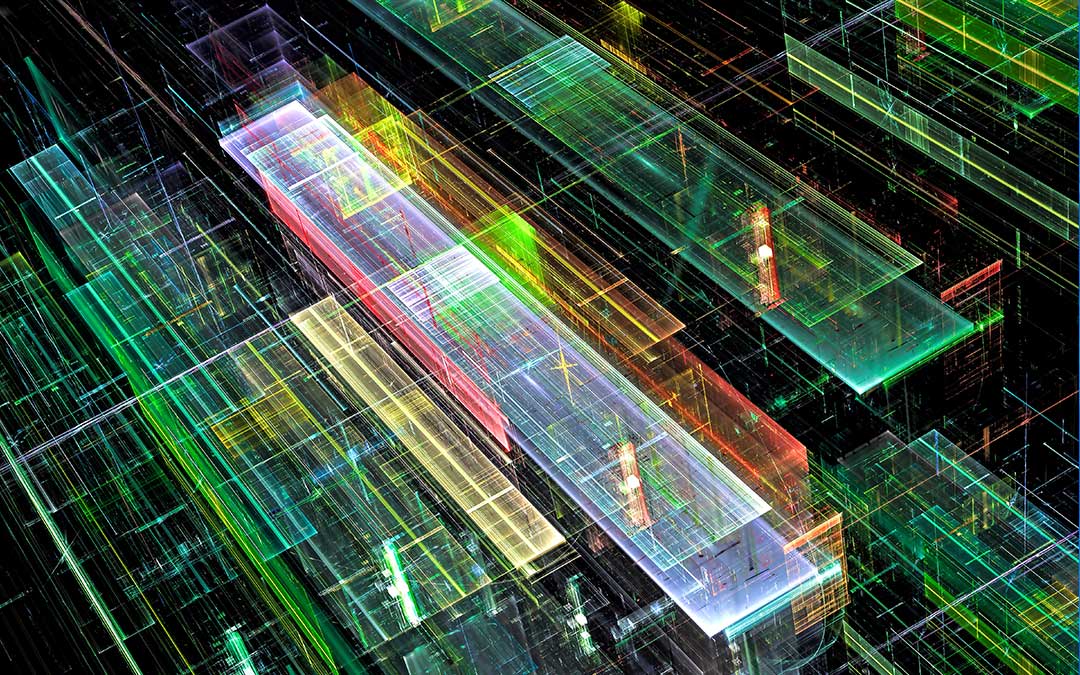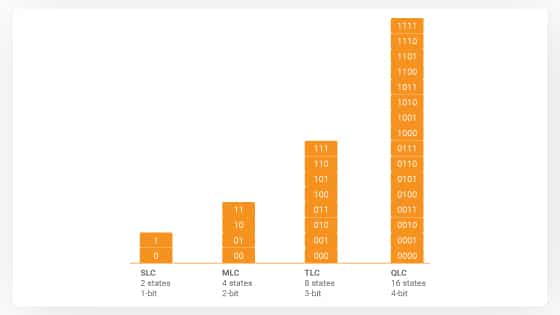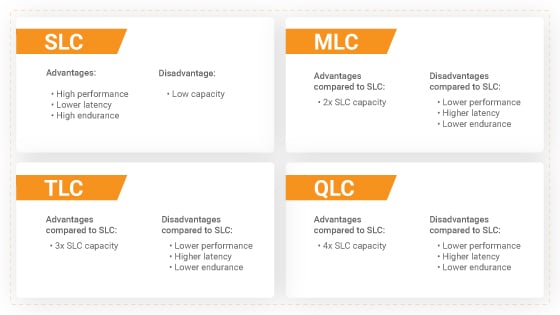In the last decade, data has grown at an exponential rate due to technological advancement in the field of “internet of things.” Exponential data growth requires advancement in the storage technology to store the generated date. Hard disk drive (HDD) and Solid-state drives (SSD), which are two main forms of storage in the modern computing system, have increased their storage capacity to meet the demand.
HDDs industry now uses heat-assisted magnetic recording or microwave-assisted magnetic recording to increase drive capacity. SSD makers have addressed the demand for higher capacity by storing more bits per NAND storage cell.
NAND flash technology
NAND Flash technology started by storing one single bit per cell— and this cell is called Single Level Cell (SLC). SLC NAND provides high throughput, high endurance, and low latency, but has small capacity. NAND technology evolved and enabled storing two bits per call and it is called —Multi Level Cell (MLC). MLC NAND provides twice the capacity of SLC NAND but has lower throughput and has less endurance. Further enhancement in the NAND technology enabled storing three bits per cell— and it is called Three Level Cell (TLC). TLC NAND has three times the SLC NAND capacity but has much lower throughput and endurance. The latest NAND technology stores four bits per cell— or Quad Level Cell (QLC). QLC NAND provides four times the SLC capacity but has much lower throughput and endurance.
How to address QLC NAND tradeoffs
QLC NAND addresses the increased capacity requirement but comes with tradeoffs of slower throughput and lower endurance. One way to address slower throughput and lower endurance of QLC is to add a small SLC cache on the drive. Data from the host is written to the SLC cache first, and then data is moved to QLC. Throughput seen by the host depends upon the workload. If the size of the data that is being written is smaller than the SLC cache size, then the host will see SLC throughput. If the data being written is larger than SLC cache size, then the combination of SLC and QLC performance will be seen.
SLC cache can also address the endurance concern of QLC NAND for specific workloads. If the host is writing and rewriting specific Logical Block Address (LBA) range and the LBA range is smaller than the SLC cache size, then the data is invalidated in the SLC cache and only the final copy of the LBA is moved to QLC.
Maximize the benefit of using an SLC cache
To maximize the benefit of an SLC cache, NAND Flash supports using QLC NAND in SLC mode. In this mode, QLC cell will be used to store only a single only single bit. This will reduces the capacity by one fourth but provides throughput and endurance of an SLC cell. When used for a “Fresh Out of Box” (FOB) drive or for applications that do not fill the drive completely, using this feature will enables a substantially bigger SLC cache, which in turn, can provide better throughput and endurance.
Consumer workload
The SLC cache benefit depends upon the workload. Can a QLC drive be a good fit with an SLC cache? Consumer drives have the following characteristics:
-
- Consumer drive workloads are bursty, which means data is written to the drive for a short duration and the drive is idle after that.
- Consumer workloads generate average Queue Depth (QD) of 4 and maximum QD of 7.
- Consumer drives write to limited Logical Block Address (LBA).
- Consumer drive are rarely filled to the maximum capacity.
QLC NAND for Consumer Drives
QLC NAND provides the best cost per bit but comes with the limitation of lower performance and lower endurance. As the consumer workload is bursty and writes to a limited LBA range, QLC NAND can be combined with SLC cache to provide a solution with good user experience and lowest cost. All the data written by the host is directed to SLC cache, providing a better user experience. When the drive is idle, data is moved from SLC to QLC. Even though QLC performance is slow, it is not seen by the host as this operation is carried out when the host is i dle.
Consumer workloads also write over a limited LBA range. W riting the data to SLC first ensures that only the final valid copy of the data is written to the QLC. This limits the writes to QLC, enabling QLC NAND to be used for consumer drive, despite its lower endurance.
SLC cache is used in the consumer TLC drive today. It takes advantage of customer workloads to address the similar limitation of lower speed and limited endurance on TLC NAND. QLC based drives provide 33% higher capacity as compared to TLC NAND. This lowers the cost of the drive.
Conclusion
Exponential data growth is driving the requirement for higher storage capacity. QLC NAND enables higher capacity but has lower performance and endurance. Combining QLC NAND with SLC cache is i deal for consumer workloads. QLC based drives provide a good user experience with the lowest cost, resulting in best value for consumers.












